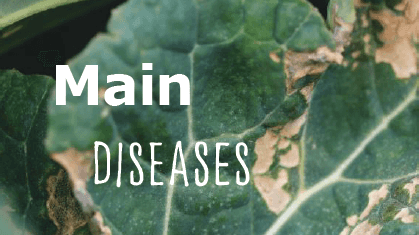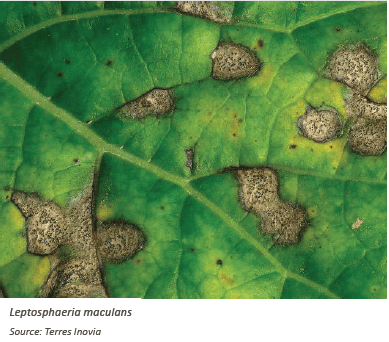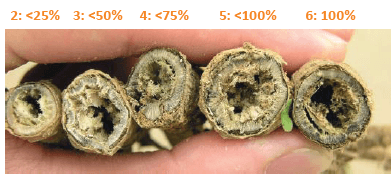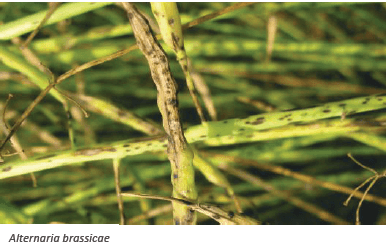MAIN DISEASES


Sclerotinia

DESCRIPTION
White mould, or sclerotinia infection symptoms occur on plant’s leaves, crown, stem and pod. At the end of winter, at the stage of vegetative restart, leaves of plant’s rosette may become soft and translucent, gradually covered with white compact mycelial growth, often arranged along the petiole. White encircling spots
appear on the stem at the level of petiole insertion and in the leaf axils. As stem lesions develop, the upper part is no longer fed and hot. Often at this stage lodging may appear. In humid conditions, spots become covered with a fungal white growth that can form sclerotia: clusters of black mycelium outside and white inside, various shapes and sizes (from a few mm to more than 1 cm). In less favourable climatic conditions, there is no sclerotia formation. The attack takes on a parchment appearance with concentric mauve streaks centred around the insertion of the petiole. During flowering, discoloured spots appear at one or more nodes. At the attacked nodes, characteristic mycelium and sclerotia may appear. Severe infection can cause stem splitting displaying a string of sclerotia. Siliques can be affected: they turn white and dry out. Sclerotia can also form there.
DAMAGE
Sclerotinia is a major disease, causing yield losses of 30% to 50% in severely affected crops. Yield loss results mainly from scalding which causes a reduction in the weight of a thousand grains and more or less ginning depending on the time of the attack and the percentage of plants affected. Strong nuisance: above 20% of plants attacked, every 10% of additional attacks cause a loss of 1.5 to 3 q/ha.
SOLUTION
• Variety: There is no varietal resistance to this disease.
• Sowing: Avoid high density sowing and reduce nitrogen input.
• Preceding crop: Frequent use of rapeseed, sunflowers, soybean, peas, field bean or alfalfa in rotation favour the disease, as do crops susceptible to disease irrigated near the plot.
• Chemical control: Preventive chemical treatment in plots at risk in stages F1, F2 of oilseed rape. Curative treatment in conditions favourable to contamination (petals stuck to leaves, very high and persistent relative humidity, average temperature above 12°C). Any treatment is ineffective once the first symptoms appear on the stem.
Stem Canker Phoma

DESCRIPTION
Symptoms mainly occur on the leaves and crown. From emergence to the rosette stage, damping-off and leaf spots are the main symptoms. Ashen grey, rounded macules or spots with black dots (pycnidia) appear on cotyledons and leaves in the autumn. They can appear later on stems. Not to be confused with pseudocercosporella spots, brown to white, which do not have black spots. At the end of winter, a grey to black cavernous necrosis can appear at the neck. Plant death from crown severing can occur from early winter until the end of flowering.
DAMAGE
Root collar necrosis prevents the plant from being nourished normally; it can even cause the taproot to sever and the plant to lodge. Yield losses can reach several q/ha (strong nuisance).
SOLUTION
Variety: Choose a variety not susceptible to the disease.
Sowing:
• Aim optimal plant establishment to avoid stem elongation
during autumn.
• Limit sowing density by sowing fewer than 40 seeds/m².
• Depending on space, do not exceed 15 feet per linear meter. Agronomic measures
• Crush and bury colza residues from previous year.
• In the event of no ploughing, export straws from preceding crops (cereals) or reduce the thickness of mulch by crushing or stubble cultivation to avoid elongation.
• Limit the application of organic fertilizers in summer (objective: fewer than 100 units of nitrogen available in the soil in the autumn). Sclerotinia sclerotiorum Preceding crop. Avoid rotations with crucifers.
DAMAGE RANKING

Cylindrosporium

DESCRIPTION
On leaves, light green spots, often going unnoticed, appear on the upper surface of the leaf blade. Small white dots on the edge of spots, acervuli, allow the disease to be identified with certainty. As they age, spots take on characteristic appearance: 0.5 to 2 cm in diameter, beige to tawny, often surrounded by acervuli, with appearance of scabs or burns. Leaf thickens, cracks and deforms. On confluence, spots form large patches and cause leaf to wilt. On stem and peduncles of elongated pods, beige to light brown, corky, transversely cracked spots are formed. In case of early attack, stems can be deformed. On siliques. Whitish, elongated, corky spots, sometimes surrounded by acervuli appear. Pods deform and open prematurely.
DAMAGE
On leaves, spots and deformations deprive the plant of part of its photosynthesis. On floral organs, attacks directly reduce production of pods and seeds. Attacks on pods or peduncles cause pods to open prematurely. Yield losses can reach 6 q/ha (moderate nuisance).
SOLUTION
Eliminate contaminated crop residues: crush them and bury them to limit spread of the fungus from year to year. Broad-spectrum fungicide treatment targeted at G1 stage sclerotinia may also reduce pressure. However, these two agronomic practices will often insufficiently reduce damage in years of heavy presence. For integrated disease management, consider a crop variety resistant to the disease.
Alternaria

DESCRIPTION
Initial symptoms are small black spots about 1mm in diameter. Mostly seen on leaves and pods, sometimes on stems at the end of flowering stage.
DAMAGE
Yield loss depends on intensity and earliness of symptoms. In the majority of except when Alternaria spreads to pods causing premature ripening and pod shattering.
SOLUTION
There are no varieties with resistance to Alternaria. Chemical control only plays a preventive role at stage G4. Crop residues of oilseed rape, or contaminated cruciferous plants in nearby fields, should be buried. Germination occurs in spring and is favoured by warm temperatures (+18°C) and alternation of rainfall and dry weather conditions.
Verticilium

DESCRIPTION
Verticillium is polyphagous. It is preserved in the form of microsclerotia in crop residues buried in the soil. The mycelium attacks roots making colonization of plant systemic. Symptoms appear on raps towards end of the cropping season. Yellowing of the leaf, usually the stem on one side of the leaf or part of the stem. Progresses to browning and necrosis of the affected tissues. Presence of micro sclerotia in affected stems. An average temperature of 21 to 25°C favours infection.
DAMAGE
Causes early senescence (aging) and decreased performance. Yield losses in severe infestation can reach 10 to 50%, yet experimental proof of such estimations is lacking (and conditions can vary from year to year). TKW and pod shattering tolerance can be affected by this disease.
SOLUTION
There are no fungicides with proven effect against this disease. Consider choosing a variety with tolerance in addition to agronomic practices like rotation with non-host crops. Bury crop residues deeply to avoid further contamination.
For more information, download our rapeseed technical guide: click here.
